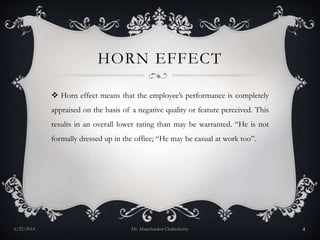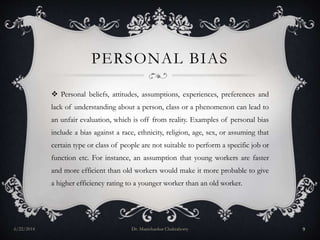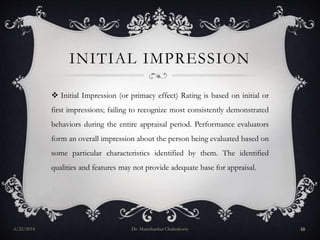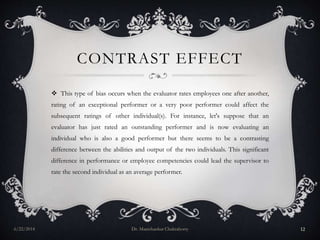Outcome 5 of Performance Appraisal and Productivity
- 1. OUTCOME-5 PERFORMANCE APPRAISAL & PRODUCTIVITY Dr. Manishankar Chakraborty Business Studies Department 6/22/2014 Dr. Manishankar Chakraborty 1
- 2. INTRODUCTION PERFORMANCE RATING ERRORS Human behavior is a complex phenomenon; thus, it is difficult to precisely measure or evaluate human’s performance. Due to the difficulties associated with the subject, the performance evaluators may make significant errors during the evaluation process. Being aware of these pitfalls can make the process more objective and could also reduce the unpleasantness that is caused as a consequence of a poorly administered performance appraisal. These common rating errors are explained below (see Henderson, 1989): 6/22/2014 Dr. Manishankar Chakraborty 2
- 3. HALO EFFECT Halo effect occurs when the evaluator attaches too much significance to a single factor of performance and gives similar ratings on other performance elements. Thus, overall evaluation is significantly influenced by a single factor. Such a perception undermines the importance of other elements and leads to an unbalanced performance assessment of the individual. For example, a manager rates a worker very high on quality because of her immaculate attention to details and lack of defects in her work. Then assuming the individual to be an overall high performer based on the quality of her work output, the manager rates her very high on efficiency, responsibility, punctuality, etc. without taking an objective look at her performance in these areas. 6/22/2014 Dr. Manishankar Chakraborty 3
- 4. HORN EFFECT Horn effect means that the employee’s performance is completely appraised on the basis of a negative quality or feature perceived. This results in an overall lower rating than may be warranted. “He is not formally dressed up in the office; “He may be casual at work too”. 6/22/2014 Dr. Manishankar Chakraborty 4
- 5. CENTRAL TENDENCY Some evaluators or performance appraisers tend to avoid problematic situations and, thus, "play safe" by rating around the golden mean - the average. This may be also done to avoid the necessity to justify scoring across the two extremes as some systems expect managers to specify additional comments as they give too high or too low ratings to employees. This rating error is known as the central tendency bias, which is regarded as an easily rationalized escape from making a valid appraisal. 6/22/2014 Dr. Manishankar Chakraborty 5
- 6. STRICT RATING In Strict Rating, employees are rated consistently lower than the normal or average; being constantly overly harsh in rating performance qualities. 6/22/2014 Dr. Manishankar Chakraborty 6
- 7. LENIENT RATING Lenient or Leniency Rating reflects an inclination to inflate all employees’ performance evaluation. In other words, there is a tendency to evaluate everyone favorably, as some evaluators tend to avoid negative arguments with employees who receive below-average ratings. In Lenient Ratings, performance evaluators rate their subordinates very liberally, which may make even average performers seem like star performers, attaining very high performance scores. 6/22/2014 Dr. Manishankar Chakraborty 7
- 8. LATEST BEHAVIOR Latest Behavior Rating (sometimes termed as Recency Effect Rating) is a rating bias, which is influenced by the most recent behavior ignoring the commonly demonstrated behaviors during the entire appraisal period. Thus, a person who has worked very hard and excelled throughout the year, but for some inadvertent reasons had faced performance issues in the last weeks or month may at times get a poor appraisal from the supervisor. 6/22/2014 Dr. Manishankar Chakraborty 8
- 9. PERSONAL BIAS Personal beliefs, attitudes, assumptions, experiences, preferences and lack of understanding about a person, class or a phenomenon can lead to an unfair evaluation, which is off from reality. Examples of personal bias include a bias against a race, ethnicity, religion, age, sex, or assuming that certain type or class of people are not suitable to perform a specific job or function etc. For instance, an assumption that young workers are faster and more efficient than old workers would make it more probable to give a higher efficiency rating to a younger worker than an old worker. 6/22/2014 Dr. Manishankar Chakraborty 9
- 10. INITIAL IMPRESSION Initial Impression (or primacy effect) Rating is based on initial or first impressions; failing to recognize most consistently demonstrated behaviors during the entire appraisal period. Performance evaluators form an overall impression about the person being evaluated based on some particular characteristics identified by them. The identified qualities and features may not provide adequate base for appraisal. 6/22/2014 Dr. Manishankar Chakraborty 10
- 11. SPILLOVER EFFECT The present performance is evaluated much on the basis of past performance. “The person who was a good performer in distant past is assured to be okay at present also”. This means allowing past performance appraisal ratings to unjustly influence current ratings. Past performance ratings, good or bad, result in a similar rating for the current period, although demonstrated behavior doe not deserve the rating, good or bad. 6/22/2014 Dr. Manishankar Chakraborty 11
- 12. CONTRAST EFFECT This type of bias occurs when the evaluator rates employees one after another, rating of an exceptional performer or a very poor performer could affect the subsequent ratings of other individual(s). For instance, let's suppose that an evaluator has just rated an outstanding performer and is now evaluating an individual who is also a good performer but there seems to be a contrasting difference between the abilities and output of the two individuals. This significant difference in performance or employee competencies could lead the supervisor to rate the second individual as an average performer. 6/22/2014 Dr. Manishankar Chakraborty 12
- 13. HOW TO OVERCOME ERRORS To overcome or minimize the aforementioned rating errors, a number of preventative measures could be taken. Henderson, 1989, suggested two educational opportunities for reducing performance evaluation errors: Improving the level of understanding of the entire performance appraisal’s process. Developing skills in observing employee behavior and results achieved. Designing information and training programs that support evaluators to accurately measure and rate employees’ performance. 6/22/2014 Dr. Manishankar Chakraborty 13












